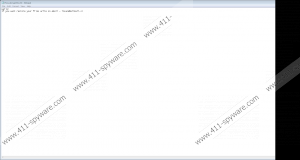'Insane@airmail.cc' Ransomware Removal Guide
If you have been attacked by 'Insane@airmail.cc' Ransomware, we have good news for you. Well, the attack itself is obviously not good as this ransomware program can encrypt your personal files in the hope of extorting some money from you for the decryption. However, we have just found out that there is a working free decryption tool on the web that you can use now to recover your encoded files. Now, this is definitely good news since you will not lose your files if you do not have a backup saved on a removable drive or in cloud storage. But even if this ransomware has an available decryptor now, we still consider it as a dangerous threat since it can push unsuspecting victims to pay the ransom and someone with no IT skills may actually lose all their files. We do not advise you to try to use this free tool yourself if you are not an advanced user. Even downloading it could be tricky since the web is swarming with fake tools that can cause you more harm. In any case, we advise you to remove 'Insane@airmail.cc' Ransomware immediately and you can worry about your encrypted files afterwards.
If this serious threat managed to infiltrate your system, it usually means that you opened a spam e-mail and clicked to see its attachment. It is important to understand that this malicious program is distributed in spam mails disguised as an image, document, or ZIP archive attachments. Hopefully, you will see now why it is not a good idea to check out any random attachment that you are not expecting to get. This spam may end up in your spam folder since spam filters are rather strict nowadays. However, unfortunately, totally legitimate and important mails can also land in your spam folder as a result of strict filtering. This is why many users check this folder every day to make sure that they do not miss out on something important.
So when you see an e-mail in your spam folder that seems to have come from the local authorities, your Internet provider, your bank, or any well-known company, it is quite likely that you will not have doubts about its importance. Even more so when you read the subject. This spam may refer to an invoice you have not paid, a problematic online booking, suspicious activities detected on your bank account, and the like. We believe that most people would be curious enough to want to see what this mail has to tell. To be frank, you would not be much wiser even if you opened this mail. It is set up to make you want to check out the attached file, which is presented as the proof or the source of the important information this spam is about. Please note that normally you would lose all your encrypted files by the time you manage to delete 'Insane@airmail.cc' Ransomware.
It is possible that this malware infection uses the RSA-2048 encryption algorithm to encrypt all your important files; at least, our research indicates so. In this attack you could lose all your media files, databases, archives, and program files as well. Fortunately, this attack does not affect your Windows system directory and your Internet Explorer, either. The encrypted files will assume a new name, which is the original name extended with a new ".[insane@airmail.cc].insane" extension. All the affected folders will also contain the ransom note text file named "How_decrypt_files.txt."
This ransomware does not seem to replace your desktop background with its scary image and does not seem to lock your screen, either. Its ransom note is very short. In fact, it only informs you that you can recover your files if you send an e-mail to insane@airmail.cc. You are supposed to get instructions in a reply as to how to proceed with the payment. It is quite possible that you will be asked to pay a certain amount in Bitcoins but we cannot confirm any amount as yet. Since a free file recovery tool has already hit the web, there is only one thing for you to do ASAP: Remove 'Insane@airmail.cc' Ransomware from your PC.
We have included our guide below this article so that you can manually eliminate this dangerous ransomware infection. It is possible that you do not want to do this manually and you do not trust your IT knowledge enough. Thus, you may want to employ a professional anti-malware application, such as SpyHunter, to automatically take care of all your current and future system security issues.
How to remove 'Insane@airmail.cc' Ransomware from Windows
- Open the File Explorer by tapping Win+E.
- Delete all suspicious files you have saved recently. (Scan your default download folders: Downloads, Desktop, %Temp%)
- Delete every "How_decrypt_files.txt" ransom note text files.
- Empty the Recycle Bin and restart your computer.
'Insane@airmail.cc' Ransomware Screenshots:


